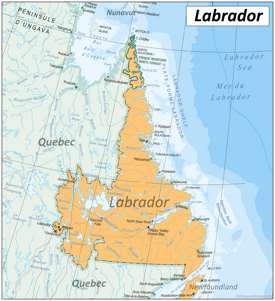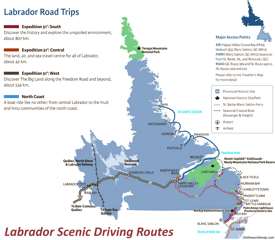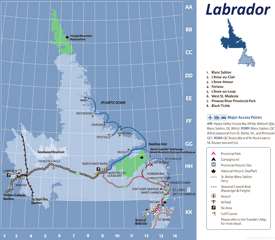Labrador Map
Description:
This map shows towns, villages, rivers, lakes, islands, and major roads in Labrador.
Size: 1500x1621px / 536 Kb
Author: Ontheworldmap.com
You may download, print or use the above map for educational, personal and non-commercial purposes. Attribution is required. For any website, blog, scientific research or e-book, you must place a hyperlink (to this page) with an attribution next to the image used.
Maps of Labrador
About Labrador
Labrador is the mainland portion of the Canadian province of Newfoundland and Labrador. It comprises the majority of the province's land area but contains only a small fraction of its population. Labrador is bordered by Quebec to the west and south, and by the Atlantic Ocean to the east. The Strait of Belle Isle separates Labrador from the island of Newfoundland to the southeast.
Geography and Area
Labrador covers approximately 294,330 square kilometers, representing about 72 percent of the total area of Newfoundland and Labrador. The region extends from the coastal areas along the Labrador Sea to the interior plateaus and the Labrador Trough, a significant geological formation rich in mineral deposits.
The coastline is deeply indented with numerous fjords, bays, and inlets. Notable geographical features include the Mealy Mountains, the Torngat Mountains in the north, and the Churchill River, one of the longest rivers in Canada. The Torngat Mountains National Park, established in 2005, protects some of the most dramatic Arctic landscape in eastern North America, with peaks exceeding 1,500 meters.
The interior of Labrador consists largely of boreal forest in the southern regions, transitioning to subarctic tundra in the north. The region contains thousands of lakes and an extensive network of rivers.
Population and Communities
Labrador has a population of approximately 26,000 people, representing about 5 percent of the province's total population. The largest community is Happy Valley-Goose Bay, which serves as the regional hub with a population of around 8,000. Other significant communities include Labrador City and Wabush in the west, which are mining towns near the Quebec border.
The population includes indigenous peoples, primarily Inuit, Innu, and Southern Inuit-Métis, who have inhabited the region for thousands of years. The Nunatsiavut region in northern Labrador is an autonomous area established in 2005 as the homeland of the Labrador Inuit.
Economy
The economy of Labrador is based primarily on natural resource extraction. Mining is the dominant industry, particularly iron ore mining in the Labrador Trough near Labrador City and Wabush. These mining operations have been active since the 1950s and produce millions of tons of iron ore annually.
Hydroelectricity generation represents another major economic activity. The Churchill Falls Generating Station, completed in 1971, is one of the largest underground power stations in the world, with an installed capacity of over 5,400 megawatts. The Muskrat Falls hydroelectric project on the lower Churchill River was completed in recent years, adding additional generating capacity.
Fishing, forestry, and tourism also contribute to the economy. The commercial fishery focuses primarily on shellfish, including shrimp and crab. Tourism is growing, with visitors attracted to the region's wilderness, wildlife, and cultural heritage.
History
Labrador has been inhabited for approximately 9,000 years. The first inhabitants were Maritime Archaic peoples, followed by various Paleo-Eskimo cultures. The ancestors of the modern Innu and Inuit peoples arrived more recently.
European contact began in the 16th century with Basque whalers and fishermen. Moravian missionaries established settlements along the coast in the 18th century, some of which continue to exist today. The region's political status was disputed between Newfoundland and Quebec for many years until the Judicial Committee of the Privy Council ruled in favor of Newfoundland in 1927, establishing the current boundary.
Transportation
Labrador's transportation infrastructure is limited due to its vast area and sparse population. The Trans-Labrador Highway, completed in 2009, connects most major communities and extends to the Quebec border. However, many remote communities remain accessible only by air or sea.
Happy Valley-Goose Bay serves as an important aviation hub with a large airport that was originally developed as a military base during World War II. Marine transportation is essential for coastal communities, with ferries and cargo vessels providing critical connections.
The Facts:
| Largest towns: | Happy Valley-Goose Bay, Labrador City |
| Population: | 26,655 (2021) |
| Area: | 113,640 sq mi (294,330 sq km) |
| Density: | 0.23455/sq mi (0.090562/sq km) |
| Coordinates: | 54°N 62°W |
| Time zone: |
UTC−4 (AST) - Summer (DST) UTC−3 (ADT) UTC−3:30 (NST) - Summer (DST) UTC−2:30 (NDT) |
| Ethnic groups: | English, Innu, Inuit, Métis |
Main sights in Labrador
- Torngat Mountains National Park
- Battle Harbour National Historic District
- Red Bay National Historic Site
- Point Amour Lighthouse
- L'Anse Amour Burial Mound
- Mealy Mountains National Park Reserve
- Churchill Falls
- Grand Lake
- Muskrat Falls
- Hopedale Mission National Historic Site
- Hebron Mission National Historic Site
- North West River
- Lake Melville
- Sandwich Bay
- Eagle River
- Trans-Labrador Highway
- Pinware River Provincial Park
- Labrador Straits
- Churchill River
- Smallwood Reservoir
- Cape Chidley
- Cartwright
- Nain
- Rigolet
- Happy Valley-Goose Bay
- Mary's Harbour
- Groswater Bay
- Forteau Bay
- L'Anse au Clair
- Port Hope Simpson
Maps of Canada
Provinces and Territories
Cities of Canada
Cities of Canada




